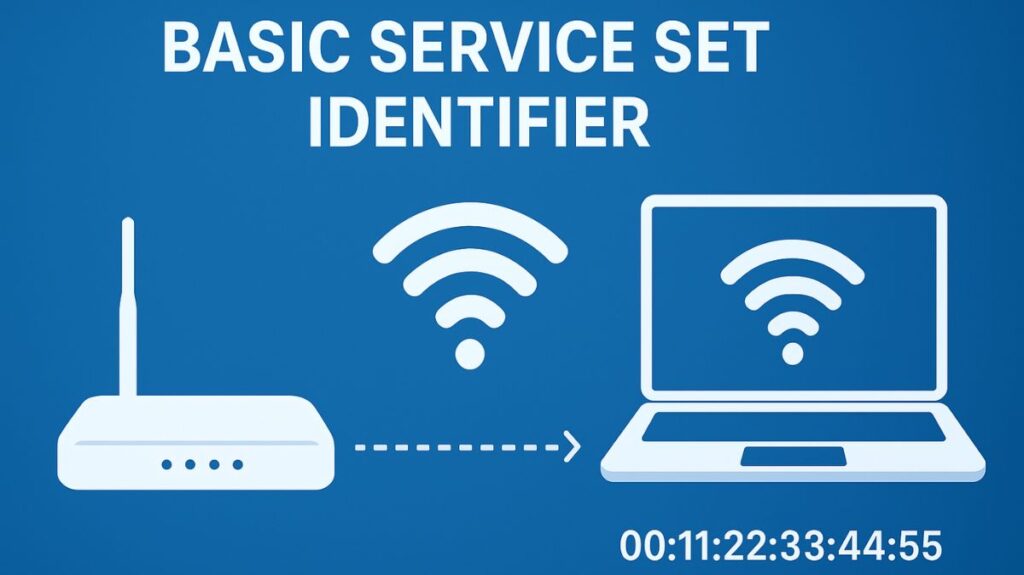What is BSSID?

An 802.11 wireless network, particularly one that is in infrastructure mode, requires a unique identification called the Basic Service Set Identifier (BSSID) to be defined and managed. Wi-Fi access points (APs) are identified to devices by their unique 48-bit MAC address, or BSSID (Basic Service Set Identifier). It is a technical identification used by devices to distinguish between individual access points, especially when they broadcast the same human-readable network name (SSID). For instance, several APs may have the same SSID in a big office building, but each AP will have a distinct BSSID.
Function in Wireless Networking
Because it enables wireless devices to distinguish between distinct access points, especially in settings where numerous APs broadcast the same network name, the BSSID is crucial.
Identification: Each AP within range provides a device with both the Service Set Identifier (SSID) and the BSSID when it scans for Wi-Fi networks. Each AP must keep a distinct BSSID, even if several APs share the same SSID (the network name).
Connection Management: Taking into account factors like signal strength and network load, devices use the BSSID to identify which particular AP to connect to. After connecting, the device communicates with that particular access point using the BSSID, frequently using it as a source or destination address for data frames.
Roaming Efficiency: The BSSID enables smooth roaming for consumers travelling across wide regions (an Extended Service Set, or ESS, where several APs share a single SSID). In order to swiftly locate and switch to an alternative AP that provides a stronger signal without the need for manual intervention, the gadget continuously analyses BSSIDs. When end users switch between APs, they usually are unaware that their BSSID has changed.
Also Read About Wireless Principles: 802.11 Standards & WLAN Basics for CCNA
Importance for Network Optimization
An essential part of efficiently managing and optimizing Wi-Fi networks is the BSSID.
Load balancing: To avoid any one AP getting overwhelmed, administrators can divide client connections among several APs using BSSID data.
Interference Management: It is possible to better control channel utilisation and reduce interference by knowing which BSSID relates to which AP.
Troubleshooting: To identify connectivity issues, such as if a device is linked to an inefficiently distant AP, network managers utilize BSSID information.
Also Read About What Is IEEE 802.1Q? The Key To VLANs In Ethernet Networks
Variations in BSSIDs
Although BSSIDs are usually a single, distinct MAC address, their implementation varies:
Single BSSID: The most standard arrangement where one AP has one unique BSSID corresponding to its MAC address.
Several BSSIDs and Virtual BSSIDs: In order to segregate traffic for segments such as employee and guest networks, an AP may broadcast several SSIDs. The AP in this instance supports several logical APs, each of which has a distinct BSSID. These derived BSSIDs are sometimes referred to as virtual MAC addresses.
Hidden BSSIDs: Pre-configured devices still require the BSSID in order to connect to the appropriate AP, even if the SSID is hidden (not broadcast).
Ad-Hoc Networks: A randomly generated 48-bit string that resembles a MAC address is used as the BSSID in independent basic service set (IBSS) or ad-hoc networks without a Wireless Access Point (WAP).
BSSID vs SSID
It’s critical to distinguish between the SSID and the BSSID:
| Characteristic | BSSID (Basic Service Set Identifier) | SSID (Service Set Identifier) |
|---|---|---|
| Identity | Unique identifier for a specific AP/BSS. | Advertises the wireless service/network name. |
| Format | Machine-readable (MAC address format). | Human-readable (text string). |
| Visibility | Used internally by devices; generally not seen by the user. | The public network name visible to users. |
Network managers must keep an eye on the BSSIDs in order to manage and maintain the network, even though users mostly interact with and care about the SSID.
Also Read About What Is Service Set Identifier SSID? How It Works & Features
